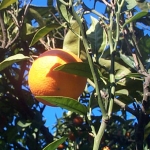| Common Name: |
Citrus Dulcis |
| Other Names: |
China Orange, Orange, Sweet Orange |
| Botanical Name: |
Citrus sinensis |
| Family: |
Rutaceae |
| Location: |
United States, Mediterranean, California, Florida |
| Extraction: |
Expression |
| Parts Used: |
Peel |
| Color and Odor: |
The essential oil is golden yellow in color and has a sweet, fruity aroma. |
| Background: |
A native of China, the sweet orange was introduced into Europe int he eighteenth century, where it flourished. Orange is a traditional ingredient in mulled wine; pierced with cloves and dried, the fruit is a popular pomander. |
| Medicinal Parts: |
Peel of the fruit, oil taken from the peel, fruit juice. |
| Properties: |
Antidepressant, antispasmodic, stomachic, sedative. |
| Medicinal Uses: |
To treat lack of appetite and stomach complaints. |
| Uses: |
- Digestive System—Promotes peristalis, easing constipation.
- Circulatory System—Valuable for treating cardiac spasm or palpitation and reducing blood cholesterol.
- Emotions—Very cheering, joyful, bright and lively, orange disperses gloomy thoughts, emotional tangles, obsessions and a fear of the unknown, creating a positive outlook. It dispels depression and sadness.
|
| Typical Dose: |
A typical daily dose of sweet orange is approximately 750 ml of juice or 10 to 15 gm of dry peel. |
| Blends: |
| Possible Side Effects: |
Sweet orange's side effects include colic when the peel is taken in large amounts. |
| Drug Interactions: |
| Taking sweet orange in the form of juice with these drugs may reduce or prevent absorption of the drug: |
| Celiprolol, (Celicard) |
Fexofenadine, (Allegra) |
Ivermectin, (Stromectol) |
|
| Bibliography: |
Aromatherapy Blends and recipes by Franzesca Watson Copyright © 1995 Thorsons, Harper Parker Publishing Inc. Pp 142-143
The Essential Herb-Drug-Vitamin Interaction Guide by Geo. T. Grossberg,MD and Barry Fox, PhD Copyright©2007 Barry Fox,PhD pg.448 |
|

